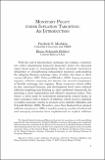Artículo
Monetary policy under inflation targeting: an introduction
Fecha
2007Resumen
With the end of intermediate exchange rate regimes, countries are either abandoning domestic monetary policy (by choosing super-hard pegs or relinquishing their national currencies altogether) or strengthening independent monetary policymaking (by adopting floating exchange rates, of either the clean or dirty variety) (Fischer, 2001, Calvo and Mishkin, 2003). Among monetary regimes, inflation targeting has become the natural complement of flexible exchange rate regimes. Many countries—which differ in size, structural features, and development level—have selected inflation- targeting-cum-floating as their preferred framework for pursuing a more independent and effective monetary policy. This choice is often made by instrument-independent central banks in open economies with a history of inflation, which need to establish a credible monetary anchor to promote price stability (Mishkin and Schmidt-Hebbel, 2002).
Colecciones
Descargar


